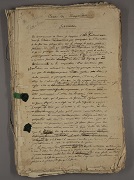Autograph Manuscript of Luigi Cherubini’s 'Cours de contrepoint et de fugue' Discovered
Maxime Margollé
Monday, November 7, 2022

We have received the following from Maxime Margollé (Postdoctoral fellow, Marie Skłodowska-Curie, Norwegian University of Science and Technology):
Published in 1835, Luigi Cherubini’s Cours de contrepoint et de fugue very quickly became a reference work. According to the Gazette musicale, 500 copies were sold on the day of its publication, and the treatise was distributed throughout the world in the years following its first edition thanks to translations in German (F. Stöpel, ca. 1836 and G. Jensen, 1896), English (J. A. Hamilton, 1837 and C. Clarke, 1854) and Italian (L. F. Rossi, ca. 1855). When Cherubini died in 1842, the Cours de contrepoint et de fugue enjoyed an undeniable high reputation both in France and internationally. Schumann, Chopin, Halévy and Auber, among many others, benefitted from Cherbuini’s book. Nevertheless, in the months following Cherubini’s death, while a sale of his manuscripts was in preparation, François-Joseph Fétis (1784–1871), a Belgian composer and pedagogue, strengthening an initial opinion given in his Biographie universelle des musiciens, expressed doubts on the work’s authorship. He wrote in the Gazette musicale: “One would be mistaken if one believed that the Cours de contrepoint et de fugue published under his name [Cherubini] contradicted my assertions on this subject, because Cherubini never dreamed of writing a dogmatic treatise on these subjects.”
Fétis took twenty-five years to clarify his suspicions: “[Cherubini] had made models for his students of all kinds of single and double counterpoints, imitations, canons and fugues: one or two sheets of principles, quite similar to what we find in Mattei’s work, preceded the examples; all of Cherubini’s pupils have copied these sheets and know, like me, what is involved. The idea of speculating on these models occurred to I don’t know who; but a text was needed; Cherubini did not want to write about it. It was, I believe, Halévy who was kind enough to take on this task for his master.”
These doubts can still be found in entries in modern encyclopedias, where the text usually is listed as a work of Halévy, as well as of Cherubini. However, as early as 1962, François Lesure and Claudio Sartori indicated in their attempt to catalog the works of Cherubini that an autograph manuscript of the Cours de contrepoint et de fugue by Cherubini was present in the Heyer collection at the beginning of the twentieth century [see note 1]. The catalogue of this collection, prepared between 1911 and 1916 by its librarian Georg Kinsky, does indeed indicate the manuscript of a “Cours de composition” by Cherubini. To strengthen his argument, Kinsky added a facsimile page of the manuscript he described [see note 2], which corresponds to page 92 of the first French edition of the Cours. Unfortunately, all trace of this document was lost during the sale of the Heyer collection on December 6 and 7, 1926. The notice, which referenced it under number 92 in the sale catalog (also written by Kinsky), included the same elements as that in the catalog of the Heyer collection published a few years earlier. On the other hand, no identification of the buyer was indicated [see note 3].
In the course of the research carried out for the preparation of a critical edition and translation of Cherubini’s Cours de contrepoint et de fugue as part of the project Between Chopin and Tellefsen: European Music Treatises – Universality and National Identity realised by the Fryderyk Chopin Institute between 2020 and 2022, I was directed to the Stiftelsen Musikkulturens Främjande, Nydahl Collection in Stockholm by Bella Brover-Lubosky. In that collection I found the manuscript described by Kinsky for the Heyer Collection, and I could retrace its journey: in 1926, Rudolf Nydahl participated in the sale of the Heyer collection and bought 330 lots. Among the manuscripts he bought was the manuscript entitled “Cours de composition” by Cherubini. Only a few details differ between that manuscript and the 1835 edition, but in order to be able to affirm with complete certainty the identity of the author of the Cours de composition preserved by the Stiftelsen Musikkulturens Främjande, a comparison of the handwriting of Cherubini and of Halévy with that of the manuscript was carried out. It has been authenticated as being in the hand of Cherubini by Sandrine Lefranc-Loisel, Expert at the International Criminal Court.
The discovery and authentication of the original manuscript of Cherubini’s Cours de contrepoint et de fugue in the Stiftelsen Musikkulturens Främjande, Nydahl Collection in Stockholm allows us to close a debate almost one hundred and fifty years old and to definitively attribute the authorship of this work to Cherubini alone.
Notes:
[1] François Lesure et Claudio Sartori, “Tentativo di un catalogo della produzione di Luigi Cherubini,” Luigi Cherubini nel II centenario della nascita, Firenze: L. S. Olschki, 1962, pp. 135–187.
[2] Ibid., table XXXII.
[3] Georg Kinsky, Karl Ernst Henrici and Leo Liepmannssohn, Versteigerung von Musiker-Autographen aus dem Nachlaß des Herrn Kommerzienrates Wilhelm Heyer in Köln, Berlin: Henrici & Liepmannssohn, 1926, p. 21.
Image: First page of the Cours de Composition in the hand of Luigi Cherubini, ca. 1810-1835. Stiftelsen Musikkulturens främjande, Stockholm (S-Smf) MMS394. RISM ID no. 1001228429 (RISM Catalog | RISM Online). Image courtesy of Maxime Margollé.
Share Tweet EmailCategory: Rediscovered

